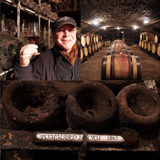
“You can’t find good wine sitting on your ass.”
Doug’s Travels
FIND GOOD SCHIST
France
Domaine Sérol: Laser Beam of Purity
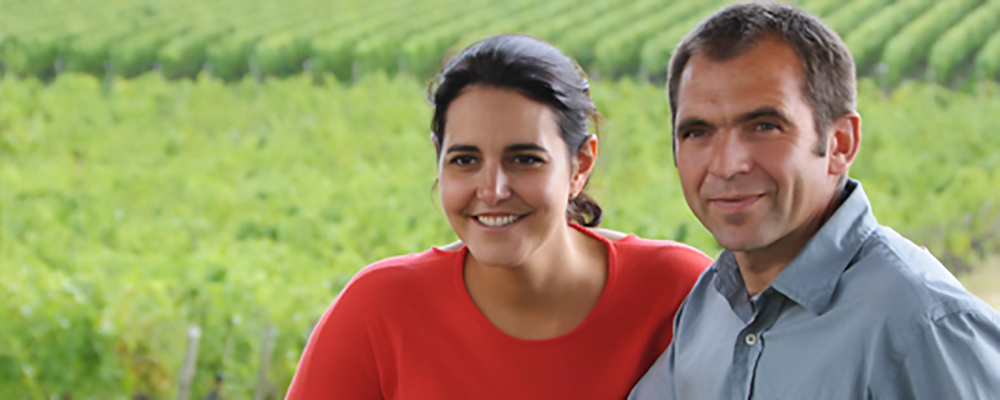
Stéphane and Carine take this business very seriously. It is their life. Stéphane started working at the family domain in 1996. His wife Carine is immersed in all facets of the business and is particularly adept at marketing and public relations.
Once in a blue moon, I taste something that kicks me in the teeth, grabs me by the throat, and changes everything I thought I knew about someone’s work. The Gamays of Stéphane and Carine Sérol did just that. They are a gamechanger. Why? Because they are as close to vinous perfection as you can get. They are everything a wine should be: crystalline, terroir-driven and utterly delicious. But they weren’t always that way. I’ve been tasting Sérol’s wines for years at the Salon de Vin de Loire (the Loire Valley Wine Trade Fair), and to be honest they just didn’t move me. Don’t get me wrong, the wines were good. They were correct. But they just lacked what I would call soul.
Fifth-generation winemaker Stéphane Serol is a shy man with a big warm simile. He rarely utters a word, and when he does say a few syllables it’s in barely audible French which, as everyone knows, I don’t speak unless I’m in desperate straits. So, needless to say, there wasn’t a lot of back-and-forth with him when we’d meet; instead, every year I’d politely taste and every year I pass on buying any.
Well, the game changed in 2016 when I tasted his 2015s. Something had clearly changed here –and in a big way. Being the naturally curious guy that I am, I asked myself, “What went so right to produce this gem of a wine? Why is it so much better than it was in previous years?” I could hazard a guess that it had to do with different soil conditions, different vinification processes, or more favorable weather conditions throughout the whole growing season than had occurred in years past. Or maybe the stars had simply aligned perfectly and enabled the Sérols to create this brilliant example of what Gamay should taste like. But to find the answer, I knew I had to reach out to Stéphane and Carine Sérol.
The Art and Science of Sérol’s Gamay
Just as I had suspected, many elements factored into their formula for success. When Carine fielded my questions about what they had changed to create such a delectable wine, she said, “First of all, it’s about the grapes. It’s always about the grapes.” She recounted that they started following organic growing practices, and then they went biodynamic,* which she said helped improve the quality of the grapes. She added, “We also learned to zero in on the ‘D-day’ for harvest by pinpointing the perfect condition of the grape for harvest (taste, condition of the skin, etc.). And we also decided to keep more whole bunches together for maceration.”
What Stéphane and Carine did was make a number of good decisions, the first and foremost of which was to be intellectually curious. Another critical decision was to be willing to take risks, to push the boundaries of the appellation, to not stop at “good” wine but to strive for “great” wine. The process of shifting the balance so you can get closer to divine wine is not swift, but for those who are intellectually curious, flexible enough to change course when indicated, and dedicated to delivering their very best, it’s invigorating.
Carine described the new orientation in the vinification process: “We’ve stopped using commercial yeasts. We’re trying to be as natural as possible during vinification,” so we use less sulfur. That wasn’t the case in the beginning, but we found that sulfur can inhibit the taste. We don’t want to do totally without it, but in the end, we filtrate it in a softer way. It’s been a lot of small things, but all around, it’s made a big improvement.”
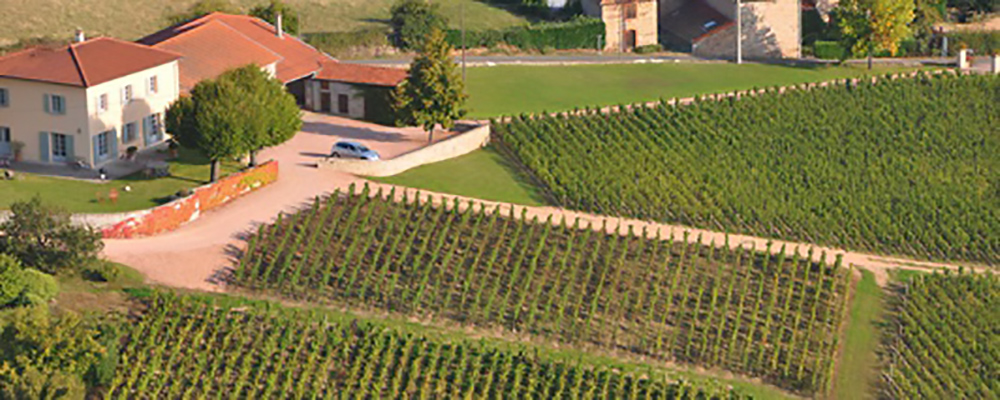
The Sérol estate covers 30 hectares (about 75 acres). It’s situated in Côte Roannaise at the foothills of the Massif Central – a highland region in the middle of the South of France consisting of 200 hectares (or about 500 acres) that includes some of the original vineyards of the Loire Valley.
Five Sérol Generations Hone the Art and Science of Winemaking
When I visited Stéphane and Carine at Domaine Sérol, I was enamored by the magical quality of the region and struck by the sheer beauty of their estate. There’s just something in the soil – and the air – that smells so clean and earthy and rich that it makes me glad to be alive. Upon my arrival, Stéphane and Carine greeted me warmly and took me on a tour of the vineyards and, later, the cellar.
Most of the Sérol estate is planted with the traditional grape variety, Gamay Saint Romain, with a few hectares of Viognier. The vines are planted at high density at relatively high altitude (about 400 to 500 meters, or 1,300 to 1,600 feet). What kind of blew my mind are the differently situated parcels. There are south-facing parcels and northeast-facing parcels, so some parcels get more sun than others. Some parcels are at 380 meters altitude and others are at nearly 500, so temperatures vary. The ages of the vines also vary dramatically: some parcels contain vines between 5 and 25 years old while others contain vines between 50 and 80 years old. And the terroir is different from parcel to parcel. There may be a gentle slope to one vineyard and another one may be relatively flat. The result? Different soil composition.
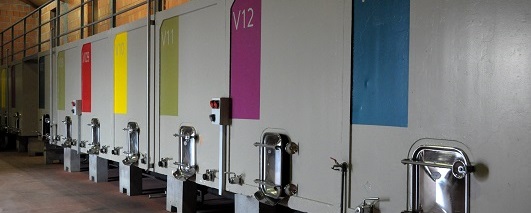
Temperature-controlled tanks in the partially underground cellar are the perfect size for vinifying separate parcels. Fermentation occurs with natural, indigenous yeasts. Pneumatic pressing followed by six months of aging and domaine bottling yields intense dark red color, aromas of red fruits (black currant and raspberry), which is typical of Gamay; mineral and spicy nose; mouth with silky tannins to give suppleness, strength and length to the wine.
In addition to wide variations in growing conditions, what also blew my mind is the number of fermentation vessels in the cellar. It’s a big room with 40 concrete vats (lined so they’re sanitary, of course). The reason for so many different vats is that every parcel and sub parcel can be fermented differently. Many winemakers just put all grapes from all different parcels into the same vat. Not Stéphane and Carine. Winemaking is as much science as it is art with them. Grapes from each parcel and each named area are put in different vats, enabling them to analyze with precision which parcels and which processes yield the best results.
The science part of the winemaking equation receives more than enough of the Sérol team’s time and attention, and it will continue to contribute to the success of their vines. But the importance of the “art” involved in presenting the fruits of their labors (pun intended) cannot be overlooked. Carine is a clever marketer and a skilled public relations personality who’s engaging and creative when dealing with buyers and collaborative partners. And speaking of collaborative partnerships, Sérol has a great deal to be proud of (and thankful for) in its mutually beneficial relationship with one of the most successful restaurants in France.
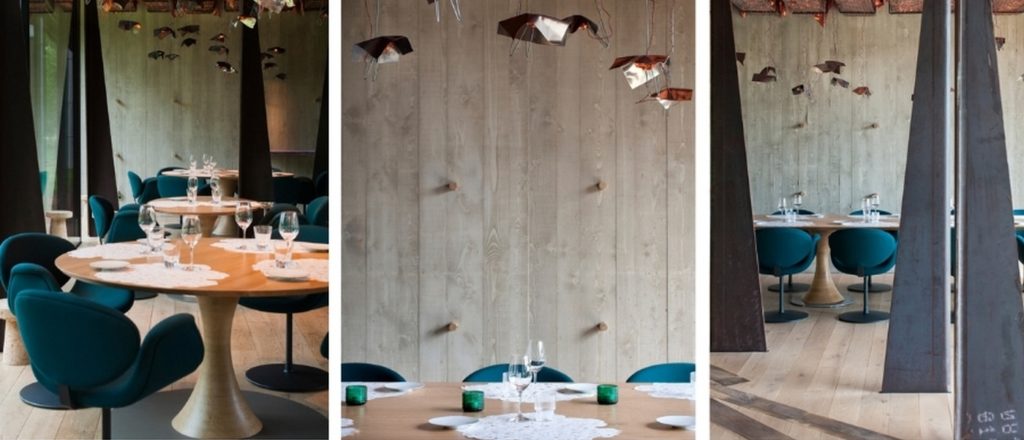
Maison Troisgros interiors are beautifully sleek and elegant, just like its food. This Michelin 3-star restaurant’s house wines are all from Sérol.
“…the relationship between Sérol and the Troisgros families and businesses goes deeper than what happens inside the restaurant. In one of the most creative and collaborative partnerships I have seen in recent years, the Troisgros family has committed to Sérol for the long haul…”
Dynamic Duo: Domaine Sérol and Maison Troisgros
The unique, highly inspiring relationship between the vineyard and Maison Troisgros, a third-generation, three-star Michelin restaurant and boutique inn in Roanne, France, is testament to the fact that the wine is supreme. (Not only is Maison Troisgros currently a Michelin three-star restaurant, it has been a Michel three-star restaurant – for thirty years!) Head chef Michel Troisgros and his father, Pierre, have featured Sérol as their house wines for many years. That’s not only because the wines are delicious, it’s also because they are so versatile that they beautifully complement virtually all food – be it pork belly, salmon or oysters.

That a restaurant of such renown has selected Domaine Sérol as its house wine is testament enough of the quality and versatility of Sérol. But the relationship between Sérol and the Troisgros families and businesses goes deeper than what happens inside the restaurant. In one of the most creative and collaborative partnerships I have seen in recent years, the Troisgros family has committed to Sérol for the long haul, by investing in some southeast-facing vineyards on the Sérol property.
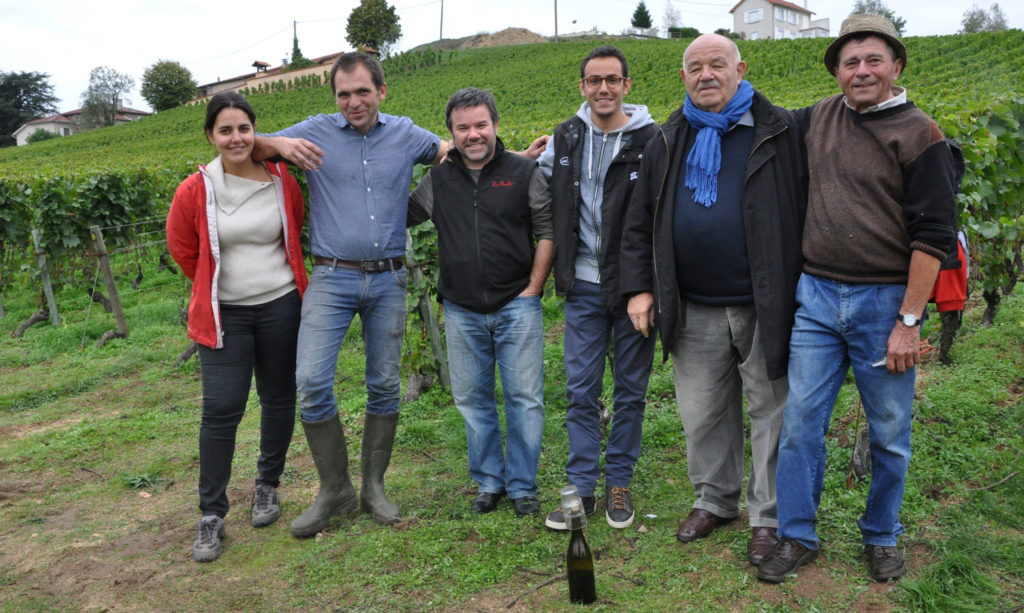
From left, Carine Sérol, Stéphane Serol, Michel Troisgros, César Troisgros, Pierre Troisgros and the Sérol Vineyard Manager. The Troisgros and Sérol families are inextricably linked to each other and to Roanne, France, northwest of Lyon. Everyone pictured here in the vineyard is ever-vigilant about the art and craft of winemaking.
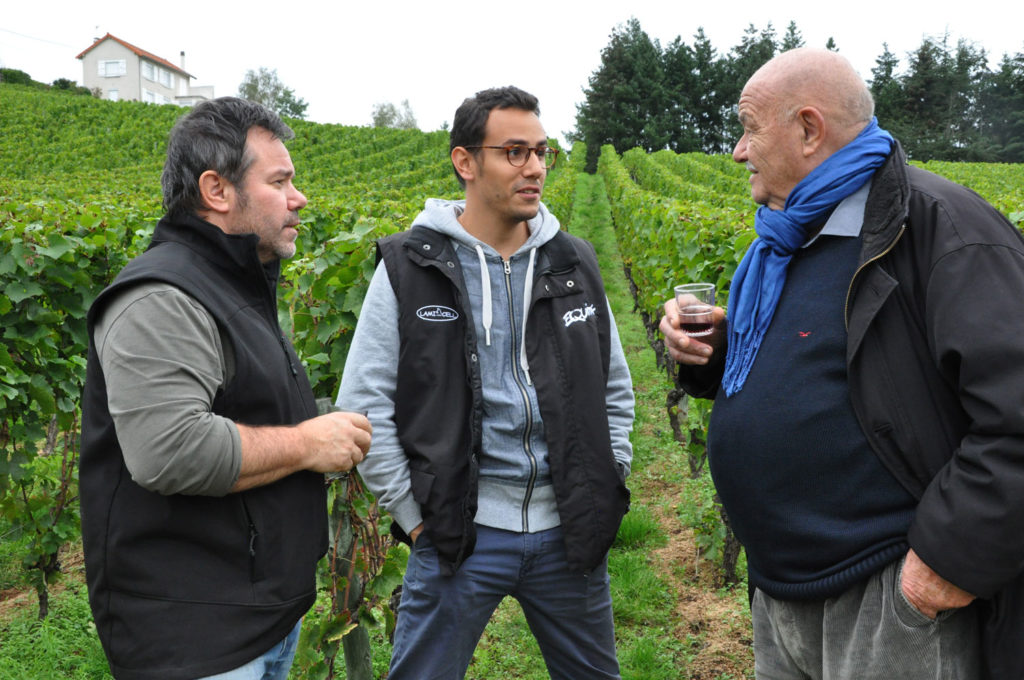
Three generations of Troisgros master chefs and, now, winemakers. From left, Michel, César, and Pierre Troisgros.
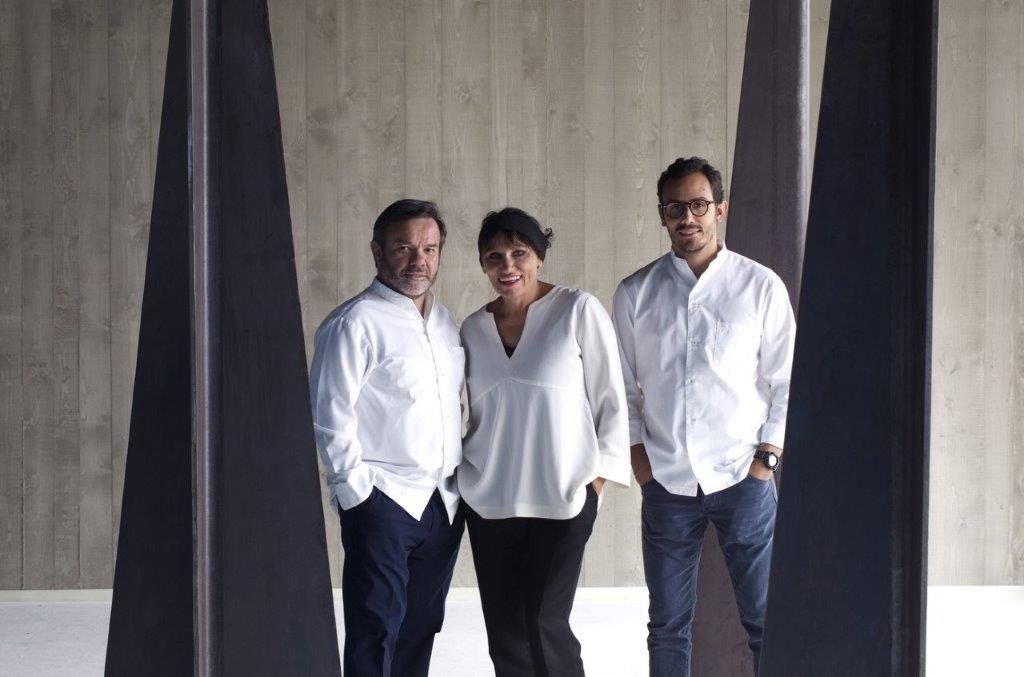
Michel and Marie-Pierre Troisgros with their son César, who represents the fourth generation of the family to perfect the food and wine pairings that merit three stars in the Michelin Guide. In addition to being a Michelin 3-star restaurant for 30 years, Troisgros was voted 25th best in the world in Restaurant Magazine’s “Top 50” in 2008.
Before closing this chapter of observations and insights gathered during my epic adventure in Roanne to explore Serol’s equation for success, I feel compelled to share one more amazing fact about this brilliant wine: The 2018 Sérol Eclat de Granite is available for $16.99 per bottle. I bought a bunch of it and want to share it with you. Don’t delay, though. I didn’t buy that much and it’s going fast.
FOOTNOTES: *Biodynamic farming is like organic farming on steroids. Both eschew fertilizer and pesticides, but biodynamic farming takes things a step further and incorporates elements of astrology. According to Food and Wine magazine (May 4, 2018), “Among its central precepts is the idea that hidden elements connect a vineyard with the farmers who care for and cultivate it – and with the wider world and universe . . . biodynamic farming relies on the orientation of the mood and stars to help determine when to plan, plough, treat and harvest – and even when to pop the cork on a bottle of wine.”
**Carine describes Domaine Serol’s commitment to vine-growing traditions: Vineyards are planted on fields of granite, sand and clay with oxidized iron. They’re plowed and the vines are nourished by prior-year cuttings, organic compost and powdered limestone (which neutralizes the soil’s acidity). Grass is planted between the rows to conserve soil. Throughout the growing season, a team of up to 15 people de-bud, trellis, and thin leaves several times. All grapes are harvested by hand before they are sorted in the cellar. Whole-bunch maceration in temperature-controlled wooden tronconic tanks is followed by partial destemming (fourteen days with natural yeasts), followed by pneumatic pressing. The wines are then aged for nearly a year, lightly filtered, and bottled onsite.